Nasi Jinggo, a culinary heritage from Bali, not only presents a delightful dish but also provides a captivating experience. Amidst Indonesia’s diverse culinary scene, Nasi Jinggo stands out with its distinctive flavors.
- History and Origins
Nasi Jinggo has deep historical roots in the daily life of the Balinese community. Derived from the Balinese word “cinggo,” meaning small, Nasi Jinggo is renowned for its minimalist portion. Unlike regular rice servings, Nasi Jinggo comes in small packages, wrapped in banana leaves, adding a natural touch to its presentation.
- Composition and Serving Style of Nasi Jinggo
Despite its small size, Nasi Jinggo lacks nothing in flavor. The rice, cooked with Bali’s signature spices, emanates an enticing aroma. Accompanied by side dishes like shrimp paste sambal, sliced chicken or fried tempeh, and boiled eggs, Nasi Jinggo provides a complete culinary experience. Its presentation in banana leaves brings a unique traditional touch.
- Cultural Significance and Local Wisdom
In line with Bali’s rich culture, Nasi Jinggo symbolizes local wisdom. This simple concept teaches the values of togetherness and simplicity in life. Behind its small portion lies the philosophy that happiness isn’t always tied to abundance but to contentment and satisfaction with what one has.
- Affordability and Popularity
The affordability of Nasi Jinggo adds to its allure. Its reasonable price makes it a choice for various societal strata, from daily laborers to tourists seeking the taste of Bali without a hefty expense.
- Culinary Tourism Allure
For tourists, indulging in Nasi Jinggo is a unique experience in exploring Bali’s local cuisine. Its unique characteristics attract travelers who seek an authentic taste of Indonesia’s diverse culinary offerings.
Nasi Jinggo, in all its simplicity, presents a unique blend of delicious flavors and deep local wisdom. It’s a dish that not only fills the stomach but also touches the heart with its message of simplicity.
Bali’s Signature Nasi Jinggo Recipe
Ingredients
main ingredients:
- sufficient amount of white rice
shredded chicken:
- 1/2 kg chicken breast
- sufficient cooking oil
shredded chicken seasoning:
- 2 tomatoes
- 30 curly red chilies
- 30 bird’s eye chilies
- 12 cloves garlic
- sufficient shrimp paste
- sufficient salt
- (after blending, divide the above ingredients in half for the plecing sambal)
- then proceed by adding:
- sufficient palm sugar
- 1 kaffir lime
plecing gondad:
- 3 bundles of gondad greens
plecing gondad sambal:
- half of the shredded chicken seasoning mixed with hot oil and kaffir lime
stir-fried tempeh:
- 1 block of tempeh (fairly large size)
- cooking oil
- sufficient sweet soy sauce
stir-fried tempeh seasoning:
- 1 large red chili, thinly sliced
- sufficient palm sugar
- 25 bird’s eye chilies (to taste)
- 8 curly red chilies
- 6 shallots
- 7 cloves garlic
- 1 tomato
- 4 candlenuts
- sufficient salt
nasi jinggo sambal:
- 7 cloves garlic
- 4 shallots
- 10 bird’s eye chilies (to taste)
- 10 curly red chilies
- 1 tomato
- sufficient shrimp paste
- sufficient salt and granulated sugar
- sufficient oil
- 1/2 kaffir lime
fried noodles:
- 2 blocks of noodles, soaked in boiling water (using thin dried noodles)
- 3 carrots
- 15 cloves garlic
- 2 bird’s eye chilies (to taste)
- sufficient cooking oil
- sufficient salt and sugar
- sufficient sweet soy sauce and chili sauce
additional components:
- boiled eggs
- serundeng (toasted coconut flakes)
- peanuts
Instructions
Shredded Chicken:
- Boil the chicken breast until cooked, shred the meat.
- Sauté the blended seasoning until fragrant.
- Add the shredded chicken, stir well until the seasoning is absorbed.
- Add palm sugar and kaffir lime juice. Stir briefly, then remove from heat.
Plecing Gondad:
- Pour half of the shredded chicken seasoning over with hot oil and kaffir lime.
- Boil the Gondad greens until tender, then drain.
- Prepare the plecing sambal by mixing half of the shredded chicken seasoning with hot oil and kaffir lime juice. Stir well.
Stir-fried Tempeh:
- Cut the tempeh into cubes.
- Sauté the blended seasoning until fragrant.
- Add the tempeh pieces, add sweet soy sauce, stir well until the seasoning is absorbed.
Nasi Jinggo Sambal:
- Sauté garlic, shallots, chili, and tomato until wilted.
- Blend the sautéed seasoning, add shrimp paste, salt, sugar, and kaffir lime juice. Mix well.
Fried Noodles:
- Boil the noodles until cooked, then drain.
- Sauté garlic, carrots, and bird’s eye chili until fragrant.
- Add the noodles, add salt, sugar, sweet soy sauce, and chili sauce. Stir well until the seasoning is absorbed.
- After preparing all these components, serve the Nasi Jinggo by arranging white rice with shredded chicken, stir-fried tempeh, Plecing Gondad, fried noodles, Nasi Jinggo sambal, boiled eggs, Serundeng, and peanuts.





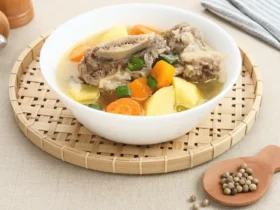


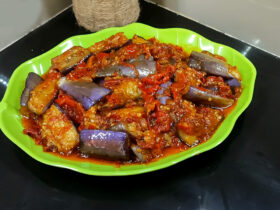
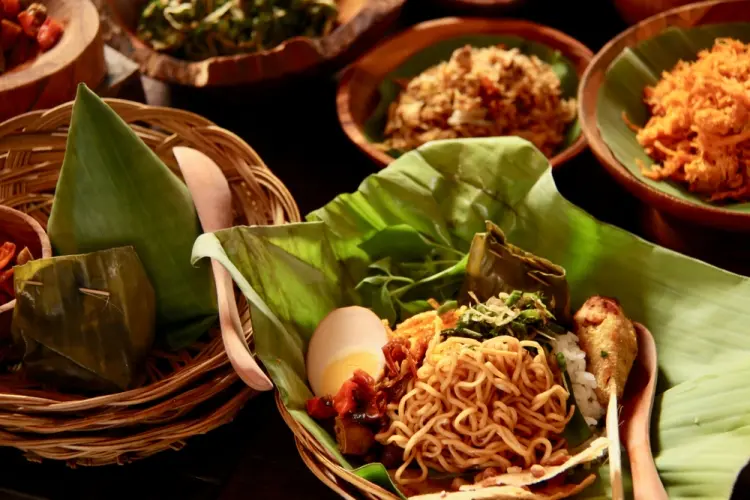







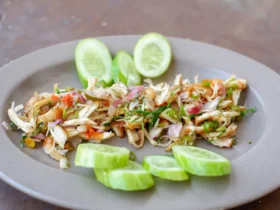
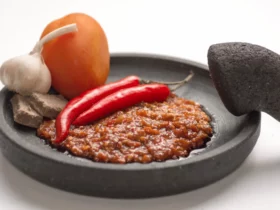
Leave a Reply